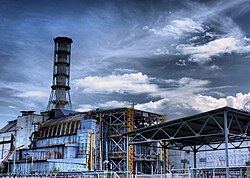Zacatlilco disaster: Difference between revisions
(Created page with "{{Region_icon_Ajax}} {{Infobox event | title = | image = 250px | caption = Reactor 2 of the Zac...") |
mNo edit summary |
||
| Line 1: | Line 1: | ||
{{Region_icon_Ajax}} | {{Region_icon_Ajax}} | ||
{{wip}} | |||
{{Infobox event | {{Infobox event | ||
| title = | | title = | ||
Revision as of 13:21, 3 March 2023
This article is incomplete because it is pending further input from participants, or it is a work-in-progress by one author. Please comment on this article's talk page to share your input, comments and questions. Note: To contribute to this article, you may need to seek help from the author(s) of this page. |
 Reactor 2 of the Zacatlilco plant was enclosed within sarcophagus containment structure after the disaster. | |
| Date | 18 March 1989 |
|---|---|
| Time | 7:19 local time |
| Location | Zacatlilco, Zacaco Republic, Zacapican |
| Type | Nuclear accident |
| Casualties | |
| 194 deaths from radiation sickness Estimated 1,000-2,000 deaths from radiogenic illnesses | |
The Zacatlilco disaster was a severe nuclear accident which occurred on the 18th of March, 1989, in the Zacatlilco atomaltepetl in the far south of the Zacaco Republic in Zacapican. It is one of the worst nuclear disasters in the history of the the world. The disaster was caused by the explosion of Reactor 2 of the Tequipanco Yocoyahuitecoc Atomtic Zacatlilco nuclear power plant, causing a massive release of dangerous radionuclides into the environment. The cleanup operations spearheaded by the CETZ emergency response forces would mobilize some 400,000 people, primarily using the Zacapine Armed Forces as manpower as well as volunteers from the civilian nuclear industry and medical sectors, and would cost 93 billion Amatl or roughly 70 million Latin solidus in total. An area of roughly 2,000 square kilometers surrounding the Zacatlilco facility would be deemed uninhabitable by the Zacapine authorities and designated as a zone of alienation, permanently displacing some 164,000 people. The official death toll of the disaster is 194 persons, the number of known deaths attributed to the explosion of Reactor 2 as well as lethal cases of acute radiation syndrome caused by the radiological contamination of the surrounding area. The true human cost of the disaster is ultimately unknown, with anywhere from 1,200 to 100,000 people all across the southern Zacaco and Tlaximallico Republics believed to have died from various cancers and other health complications as a result of the disaster.